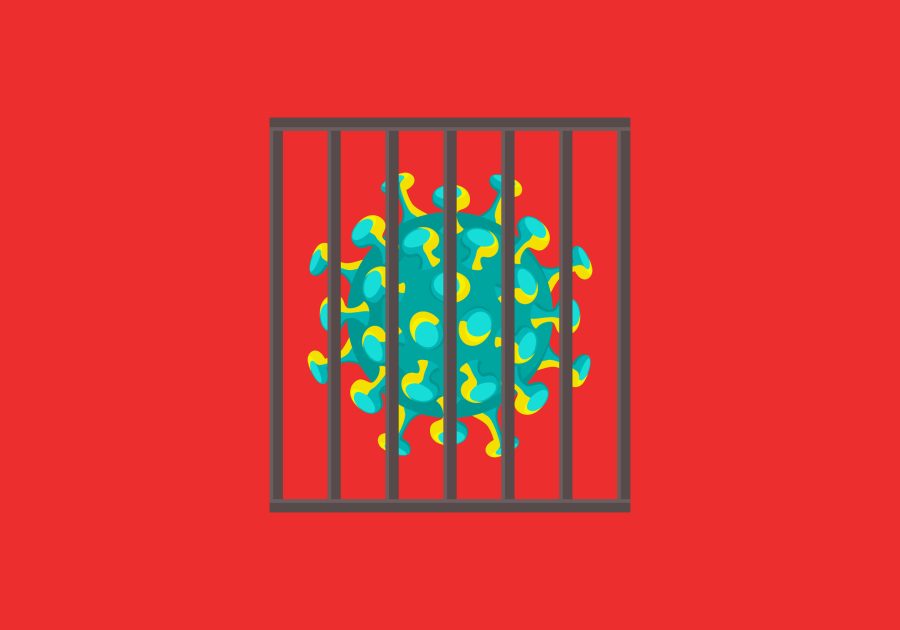The Impact of COVID-19 on Prisons: A User-led Perspective

Queen’s University Belfast researchers discuss their landmark study on the impact of COVID-19 measures in prisons.
Gillian McNaull & Shadd Maruna
From the onset of the COVID-19 pandemic, prison institutions were recognised as a site of distinct and heightened contagion risk. The risk of COVID-19 transference in closed institutions presented governments with two options: first, to reduce contagion risk via policies of decarceration; or second, to attempt mitigation of risk transference through widespread programmes of prisoner confinement and isolation. Across Her Majesty’s Prison and Probation Service (HMPPS) estate in England and Wales, the latter choice was taken. An unprecedented lockdown of strict Covid-responsive measures was implemented across the system to curb the transmission of the virus. Initially, these extreme measures were heralded as a great success, making prisons ‘safer’ and ‘less violent’ than before the pandemic.
Our recent research findings counter this argument, centring the lived experience of prisoners to highlight the real impact of COVID-19 across HMPPS estate. ‘Coping with Covid in Prisons’ is a project funded by the Economic and Social Research Council, led by partners from the School of Social Sciences, Education and Social Work at Queen’s University Belfast and the prisoner-led charity, User Voice. Using an innovative peer-led methodology, the team trained over 100 serving prisoners in research methods, who completed 1,400 surveys with fellow prisoners across 11 prisons of the English estate, to produce one of the most comprehensive studies of life in prison during the pandemic.
We found that Covid-responsive measures created long periods of solitary confinement, with 85% of surveyed prisoners locked up in cells for 23 hours a day during the lockdown period. At the same of data collection, 80% of those surveyed still experienced unlock for only 2 hours or less a day. These measures have fed into a severe mental health crisis in prisons. Incarcerated people suffered tremendously as an outcome of these prolonged periods of isolation, and the simultaneous pull-back of institutional support. Two thirds of those surveyed reported that mental health support had declined over this period, while the same number considered mental wellbeing had never been worse in prisons. Using standard screening tools to measure anxiety and depression levels, we found that prisoners scored disproportionately higher than the general population and pre-pandemic prisoner levels, with over one third of prisoners experiencing “severe anxiety disorder” indicating high levels of post-traumatic stress, and 49% scoring in the “severe depression” range. The deterioration of mental health led to participants harming themselves and their environment in their efforts to cope with the isolation they were experiencing. 42% of survey participants reported that in the preceding two weeks, they had thought they would ‘be better off dead’ or were considering harming themselves with 18% experiencing these thoughts every day.
An additional impact was the almost complete eradication of rehabilitation culture, as education, employment and purposeful activities declined significantly. Over 75% of participants reported that access to education and psychological programmes had worsened, with 85% prisoners receiving little or no programme support. This affected prisoners’ ability to progress through their sentences and work towards release, effectively trapping prisoners in categories, and impacted ability to reintegrate on release.
Many focus-group participants feared that lockdown would become the “new normal” for those in prison, ‘Every day is hopeless. It’s the new normal.’ These concerns was two-pronged; first, respondents felt the prison system was ‘already broken’, with Covid now ‘an excuse’ used to mask issues relating to under-resourcing of prisons. Second, participants believed the restrictive regimes implemented during Covid-responsivity were preferable for staff, leading to a reluctance to move to a post-Covid regime. An aspect of the ‘new normal’ was the idea some participants held that HMPPS wanted to keep lockdowns in place due the ‘myth of violence reduction.’ While personal safety had increased in prisons for a small minority of prisoners (around 1 in 6), 54% of participants disagreed or strongly disagreed that ‘most people welcomed the lockdown because it has reduced violence and bullying’. Many participants reported that the face of prison violence had changed, with verbal bullying and coercion still in place and lockdown in fact exacerbating the risk of violent outbreaks, rather than reducing it.
In the face of prison institution deficits during this period, peer support and mutual aid became the glue that enabled survival of Covid lockdowns. When asked to rate the support they received from various sources on a scale of 1 to 10, peer support from fellow prisoners was rated higher than any other group internal to the prison. However, while respondents suggested that formal and informal peer support could be crucial elements of surviving lockdown for prisoners — plugging the hole left by third sector withdrawal and staffing shortages — participants also recognised that these initiatives were under supported and ill-equipped to respond to some of the very serious mental health problems they witnessed
Our research shows the potential of peer-led approaches to produce counter-discourse to official institutional narratives. Moreover, a user-led methodology highlights both the importance and efficacy of centring lived experience in knowledge production on prison life. We recommend that prisons should and could harness lived experience of prison as a central aspect of transition to recovery.
